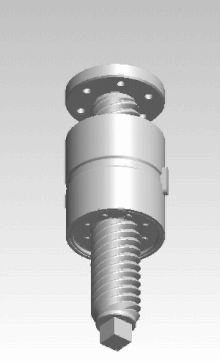Planetary roller screw drive
Planetary roller screws are screws in the drive systems in which ground planetary screw rollers , in a nut between two hole rims passed to a special roles threaded spindle rotate, resulting in a relative axial movement between nut and spindle is obtained. In the typical application, e.g. B. when moving the slide of a machine tool, the threaded spindle rotates while the nut is fixed in the circumferential direction and is linearly displaced. This system is also available as an inverted version, in which planetary thread rollers and perforated rings are axially together with the push rodmove. This design can be combined with a hollow shaft motor to form a compact actuator with a smooth push rod, which looks similar to a pneumatic cylinder .
functionality
The name planetary roller screw drive is derived from the type of rotation of the rollers around the spindle, which revolve around a central star like planets . Spindle, roller and nut diameters are selected so that the peripheral speeds of the spindle and rollers match. The synchronization is carried out by a ring integrated in the nut with internal teeth that mesh with pinions at the ends of the rollers. Since, unlike the balls in the ball screw drive or the roller screw drive with roller return , the rolling elements do not move in the longitudinal direction relative to the nut, no return mechanism is necessary. This enables higher speeds than, for example, with ball screws.
The high load ratings of the roller screw drives result from the large number of load-bearing contact surfaces. A typical roller screw drive has around 10 rollers with 15 to 25 turns. This results in 100–200 contact points. In order to achieve the same load rating with a ball screw drive, either a large number or very large balls would be required. A thread roll thus fulfills the function of a large number of balls lying on top of one another in a significantly smaller space.
Very small thread pitches can be achieved with roller screw drives. In the case of ball screws, the pitch must be greater than the ball diameter so that their raceways do not overlap. This restriction does not apply to the roller screw drive. However, when the incline is steep, the sliding portion of the roller movement increases, which reduces the efficiency.
These linear drives are therefore particularly suitable for high loads and medium speeds.
lifespan
The service life ( ) of a roller screw drive is calculated using the dynamic load rating , as is the case with roller bearings and ball screws . Since only axial forces ( ) are permitted anyway , there are no radial and axial coefficients. The following applies to the characteristic fatigue life of the planetary roller screw drive:
As with rolling bearings, this is the service life that is reached or exceeded with a 90% probability. The service life of planetary roller screw drives is typically longer than that of ball screws.
Applications
In particular in combination with servomotors and the corresponding control technology , there are many possible applications. In principle, hydraulic and pneumatic cylinders can be replaced, for example. Often times, energy savings can be achieved due to the better efficiency . Compared to hydraulics, there is also no hydraulic fluid and the associated environmental and safety problems. Due to the high rigidity of the overall system, the position and speed control is usually much easier than with hydraulic or pneumatic drive systems. Typical applications are motion simulators, presses, robot welding guns, dosing systems, assembly stands and valve drives. Forces of up to approx. 200-300 kN and speeds of up to approx. 1.5 m / s are usually required.
See also
Individual evidence
- ↑ Manfred Weck: Machine tools 2 - construction and calculation . Springer DE, 2006, ISBN 978-3-540-30438-8 , p. 479





